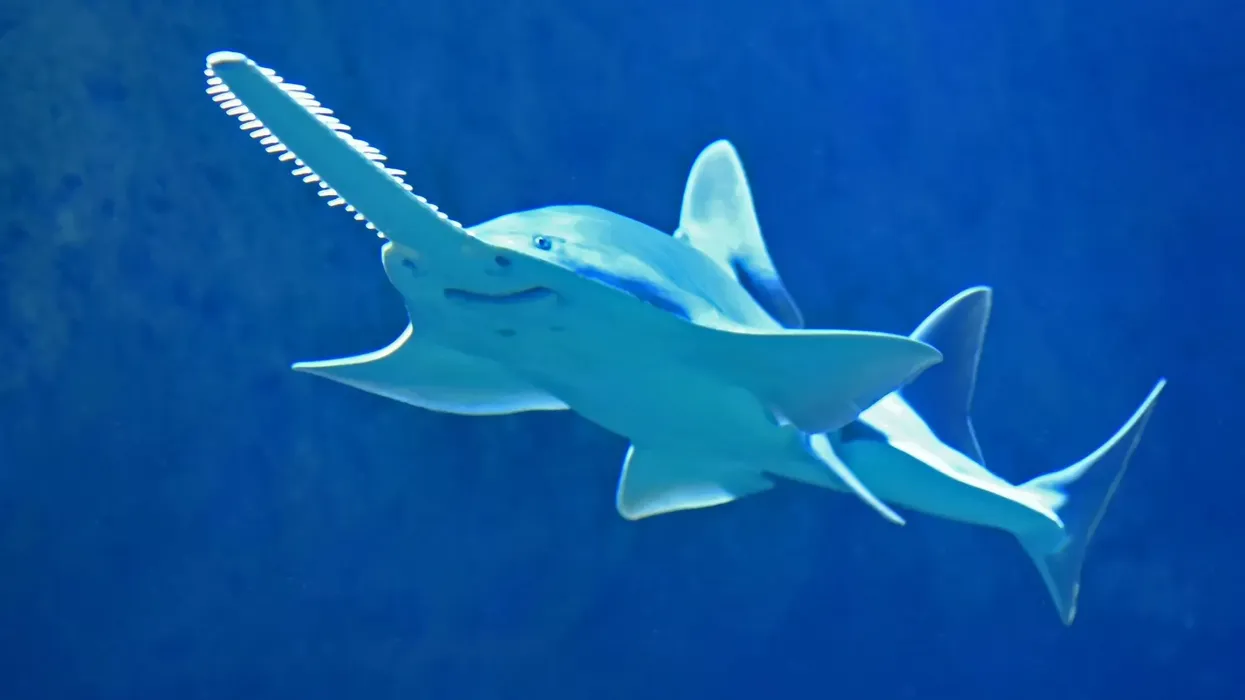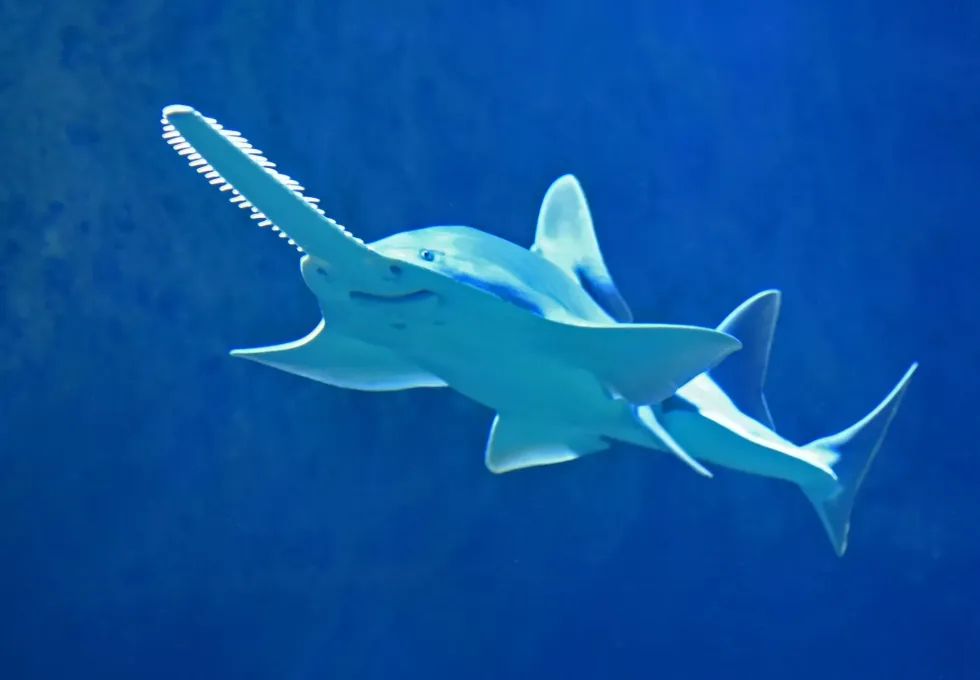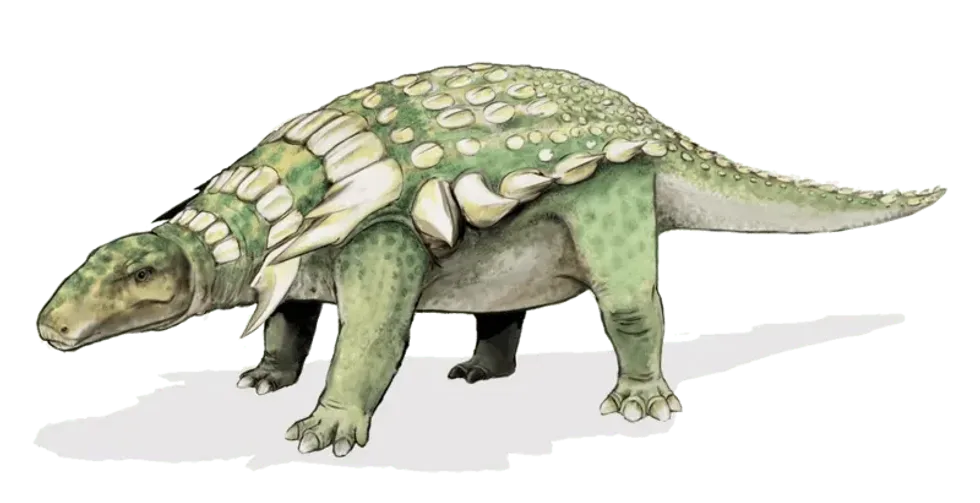The narrow sawfish (Anoxypristis cuspidata) is also known as the knifetooth sawfish or the pointed sawfish. It belongs to the species of sawfish in the family Pristidae. Even though they look somewhat like sharks, they can be differentiated by the long, narrow, flattened rostrum.
The pointed sawfish can be found in areas of the Indo-Pacific Ocean and lives in a depth range of almost 100 m (328 ft). All sawfish are highly modified, elongated rays and have the ability to breathe while laying on the seafloor by drawing water into their gills through the large hole behind their eyes called a spiracle.
The knifetooth sawfish can be differentiated from other sawfish species by the number of teeth. The Anoxypristis cuspidata has more denticles than any other sawfish.
Scroll down to read about the narrow sawfish life span, what they feed on, their habitat, and other exciting details! If you want to discover more like the knifetooth sawfish, take a look at largetooth sawfish and stingray facts.
Knifetooth Sawfish Interesting Facts
What type of animal is a knifetooth sawfish?
The knifetooth sawfish (Anoxypristis cuspidata) is a species of sawfish that belongs to the order of Rhinopristiformes.
What class of animal does a knifetooth sawfish belong to?
These narrow sawfish belong to the Chondrichthyes class and are carnivorous marine fishes.
How many knifetooth sawfish are there in the world?
There isn't an exact assessment of the number of narrow sawfish in the world, but the species has been endangered for a while due to having been overfished for the oil that can be extracted from them and also for their skin.
Where does a knifetooth sawfish live?
The narrow sawfish distribution is in the Indo-West Pacific Ocean. The distribution of the sawfish is in waters of Iran, India, Sri Lanka, Bangladesh, Malaysia, Burma, Indonesia, and Papua New Guinea.
In Indo-West Pacific regions, this endangered species can be found in the Arabian Sea, until Somalia.
Its northern limit is the Gulf of Chihli, China, South Korea, the Red Sea to the Yellow Sea, and it can also be found in the southern part of Japan. The southern limit of this species is up to Northern Australia and its states.
What is a knifetooth sawfish's habitat?
The knifetooth sawfish (Anoxypristis cuspidata) distribution is in areas of warm marine and freshwater bodies. They can habitat in a wide range of salinity and move between soft bottom substrates, such as sand, mud, or seagrass, to rocky or coraline habitats.
This species is benthopelagic and stays about 328 ft (100 m) deep in water bodies. Adults can be found in shallow coastal areas, whereas young ones tend to stay inshore.
Who do knifetooth sawfish live with?
The narrow sawfish (Anoxypristis cuspidata) is a solitary animal that mostly stays alone and only congregates before the mating period in shallow coastal areas. After the mating season passes, the fish population tends to go back to being primarily solitary and moves to deeper habitats.
How long does a knifetooth sawfish live?
This species of sawfish has a life span of about nine years and having an Endangered status, there has been a prominent decline in the number of narrow sawfish. Even though its life span is reported to be nine years, theory points that it might be 27 years, which isn't proved as of yet.
How do they reproduce?
The breeding behavior of the pointed sawfish is still being explored, but the little information that has been collected states that like all other sawfishes they have a placental yolk sac. The reproduction happens internally and after breeding is over, a number of young develop at a time in the oviduct.
The mating season depends on geographical areas and after mating, the gestation period is about five months. The litter size varies from about 6-23 pups and their size is about 16.929-24.016 in (43-61 cm).
Rostral teeth are not fully developed at birth and are covered with a sheath of tissue before birth so that the mother doesn't get hurt. After birth, rostral teeth develop gradually.
What is their conservation status?
According to the IUCN Red List, the narrow sawfish is an Endangered species. Due to fishing for their fins to make soup and for their rostrum as trophies, this sawfish species is highly fished. Another reason is the degradation in habitat. Due to a decline in the quality of water bodies, all marine animals are suffering.
Knifetooth Sawfish Fun Facts
What do knifetooth sawfish look like?
The pointed sawfish has a dorsal body that is gray in color and gradually fades into a lighter shade of gray. The total length of the female goes up to 15 ft 5 in (4.6 m) and the male grows up to 96 in (2.4 m).
It looks like a shark but has a distinct feature that differentiates it from sharks. The narrow sawfish has a long, narrow, flattened head that protrudes forward into a long snout-like bony structure.
The long, flat rostral is studded with rostral teeth along the margins. These sideways facing teeth can number 18-21 pairs in Australian narrow sawfish, while in other regions it can go up to 25 pairs. These denticles are short, flat, and roughly triangular in shape.
Its rostral teeth are white in color and it contrasts with the grayish rostral saw which turns dark brown at the base. Fins of the sawfish are light gray as well. Nasal flaps conceal narrow nostrils of the sawfish.
https://unsplash.com/photos/0O3hHyDjNpQ
(When looked at from below, the narrow sawfish looks like it is smiling.)
How cute are they?
If the rostral saw is forgotten for a moment then the narrow sawfish is quite adorable. Shark movies have made us quite scared of rays and sharks, but being harmless to humans adds a likable advantage to this sawfish species.
Even then they are not as cute as manta rays which have become a child's favorite deep waterbody animal because of children's movies.
How do they communicate?
The narrow sawfish has electroreception organs which helps it to locate other sawfishes and potential prey or threats as well. This super sense enables them to communicate with others without making any swift movements or sounds.
How big is a knifetooth sawfish?
The pointed sawfish grows up to about 137.795-157.48 in (350-400 cm) in length. This makes it almost two times smaller in length than the largetooth sawfish which is almost 240-276 in (600-700 cm) in length.
How fast can a knifetooth sawfish swim?
There is no exact data on the speed of the sawfish, but being one of the large species in shallow water bodies, it is quite fast. Its dorsal fins help it swim faster than most fishes. It can use its fins as well to change paths quicker.
How much does a knifetooth sawfish weigh?
A pointed sawfish can weigh up to about 1.102-1.323 lb (500-600 g). The thresher shark weighs about 500-775 lb (227-352 kg) which makes it more than five times bigger than the narrow sawfish.
What are the male and female names of the species?
There are no separate names for the narrow sawfish and they are just known by their general names or the scientific name.
What would you call a baby knifetooth sawfish?
The newborn of a knifetooth sawfish is called a pup. Until they grow up and have the perfect amount of rostrum denticles, they are denoted as pups.
What do they eat?
The knifetooth sawfish diet consists mostly of small fish, squid, and invertebrates like shrimps, and crabs like the hermit crab. Once it detects its prey using its electromagnetic sense, it sways its long snout-like bony structure with the rostrum from side to side in order to stun the prey or incapacitate it.
Blade-like teeth are capable of killing prey or potentially making prey easier for the Anoxypristis cuspidata to kill.
Are they dangerous?
They are quite small and do not harm humans if left unbothered. If they get tangled in fishing nets or are in danger of being captured, they might use their snout or denticles to attack.
To other animals the narrow sawfish doesn't possess any harm mostly, as being quite small in size, they are prey to other bigger sharks most of the time.
Would they make a good pet?
These fishes are generally safe to humans and do no harm, but when captured they can hurl their snout side to side in order to attack which can be quite fatal to humans.
Moreover, for a human, it is quite impossible to create perfect living conditions for this sawfish species as it tends to live in areas of warm marine and freshwater bodies.
It can tolerate a wide range of salinity and move between soft bottom substrates, such as sand, mud, or seagrass, to rocky or coraline habitats.
It is illegal to target, harm, harrass or handle a sawfish, as they are an endangered species. Therefore, removing them from the water or keeping them as a pet is a clear violation of the law.
Did you know...
The narrow sawfish is the only living species of the genus Anoxypristis but was recently added to the genus Pristis. The major difference between the pointed sawfish and other Pristis animals is that it has a narrow rostral straw with numerous teeth on the distal part.
How many teeth are in a sawfish mouth?
The rostrum of the narrow sawfish is filled with teeth that can number 18-21 pairs in Australian adults, while in other regions teeth can go up to 25 pairs in adult narrow sawfish.
What kind of fish is a knifetooth sawfish?
The knifetooth sawfish is a species of sawfish and can be found in both warm marines and in a freshwater water body. Its general habitat is bays, estuaries, and shallow riverbeds.
Here at Kidadl, we have carefully created lots of interesting family friendly animal facts for everyone to discover! Learn more about some other fishes including sawfish facts and blacktip reef shark facts pages.
You can even occupy yourself at home by coloring in one of our free printable intricate fish coloring pages.







